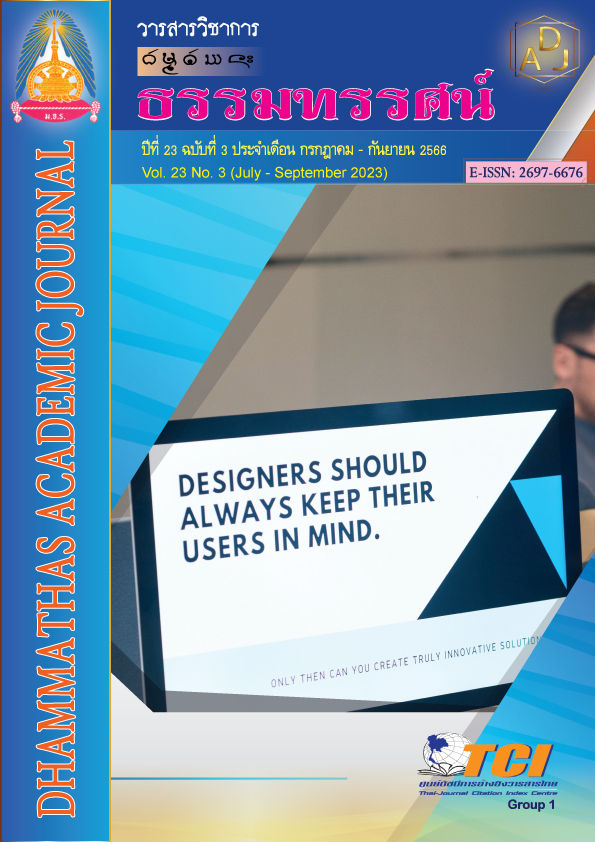Attitudes of Students Using Open-Ended Problem
Main Article Content
Abstract
This study aimed to analyze the connection by using students’ “Mathematical Attitudes” in the mathematics classroom using Open-Ended Problem. The target group was thirty-four eleven-grade students in the second 0f semester 2021. The tools used for data collection were 7 learning management plans, a field note, a field record, voice record from application ZOOM and student’s mathematical attitudes survey. Before collecting data the researcher prepared the preparations in 2 phases: Phase 1 prepared teachers and Phase 2 prepared the target students. Data analyzed from protocols, and student’s mathematical attitudes survey.
The results indicated that: 1) creating a learning management plan together designing a research lesson, the lesson study team created with focus of open-ended problem that allow students to approach problems and find their own solutions. 2) In collaboratively observing the research lesson, behavior the student's speech while solving the problem that shows the student's mathematical attitudes include: (1) See and think mathematically, students can understand the problem, defined and specify what the problem needs to be solved. (2) Pose questions and develop explanations, students are introduced to concepts from anticipance’s methods for solving problems, can express their own ideas step by step, questions were raised about the concept. (3) Generalize and extend, such as mock-up drawings Assigning symbols that express their own ideas for solving problems, and (4) appreciate others’ ideas and change representations for meaningful elaborations, when they were exchanging or discussing ideas, students tried to use the ideas of others as a basis for self-understanding. 3) Collaboratively discussing and reflecting, Students have to formulate concepts to solve problems able to communicate and use mathematical language problems in their own order of thinking.
Article Details

This work is licensed under a Creative Commons Attribution-NonCommercial-NoDerivatives 4.0 International License.
เพื่อให้เป็นไปตามกฎหมายลิขสิทธิ์ ผู้นิพนธ์ทุกท่านต้องลงลายมือชื่อในแบบฟอร์มใบมอบลิขสิทธิ์บทความ ให้แก่วารสารฯ พร้อมกับบทความต้นฉบับที่ได้แก้ไขครั้งสุดท้าย นอกจากนี้ ผู้นิพนธ์ทุกท่านต้องยืนยันว่าบทความ ต้นฉบับที่ส่งมาตีพิมพ์นั้น ได้ส่งมาตีพิมพ์เฉพาะในวารสาร วิชาการธรรม ทรรศน์ เพียงแห่งเดียวเท่านั้น หากมีการใช้ ภาพหรือตารางของผู้นิพนธ์อื่นที่ปรากฏในสิ่งตีพิมพ์อื่นมาแล้ว ผู้นิพนธ์ต้องขออนุญาตเจ้าของลิขสิทธิ์ก่อน พร้อมทั้ง แสดงหนังสือที่ได้รับการยินยอมต่อบรรณาธิการ ก่อนที่บทความจะได้รับการตีพิมพ์References
ไมตรี อินทร์ประสิทธิ์. (2549). การปฏิรูปกระบวนการเรียนรู้วิชาคณิตศาสตร์ของนักเรียนชั้นมัธยมศึกษาด้วยยุทธวิธีปัญหาปลายเปิด. ขอนแก่น: มหาวิทยาลัยขอนแก่น.
_______. (2559). การพัฒนาแนวทางการสอนคณิตศาสตร์ที่เน้นการแก้ปัญหาโดยใช้แนวคิดของนักเรียนเป็นฐาน. (รายงานการวิจัย). ขอนแก่น: มหาวิทยาลัยขอนแก่น.
_______. (2564). การออกแบบการจัดการเรียนการสอนชั้นเรียนแบบผสมผสาน (BLC). เอกสารประกอบการอบรมสำหรับการนำหลักสูตรฐานสมรรถนะลงสู่ชั้นเรียนโดยใช้นวัตกรรมการศึกษาชั้นเรียนและวิธีการแบบเปิด. ขอนแก่น: สถาบันวิจัยและพัฒนาวิชาชีพครูสำหรับอาเซียน.
วีระยุทธ พรพจน์ธนมาศ. (2557). องค์ประกอบของธรรมาภิบาลในโรงเรียน. นักบริหาร, 34(34), 80-88.
Di Martino, P., & Zan, R. (2015). The construct of attitude in mathematics education. In B. Pepin & B. Roesken-Winter (Eds.), From beliefs to dynamic affect systems in mathematics education, Advances in Mathematics Education, (pp. 51-72). Retrieved from https://link.springer.com/chapter/10.1007/978-3-319-06808-4_3
Ismail, S. O., et al. (2015). Design and development of an improved palm kernel shelling and sorting machine. European International Journal of Science and Technology, 4(2), 225-240.
Isoda, M., et al. (2017). SEAMEO Basic Education Standards (SEA-BES): Common Core Regional Learning Standards (CCRLS) in Mathematics. Retrieved from http://hdl.handle.net/2241/00157630
McLeod, D. B. (1992). Research on affect in mathematics education: a reconceptualization. In D.A. Grouws (ed.), Handbook of Research on Mathematics Teaching and Learning, (pp. 575-596). New York: MacMillan.
Wilson, J. W. (1971). Evaluation of Learning in Secondary School Mathematics in Handbook on Formative and Summative Evaluation of Student Learning. New York: McGraw-Hill.

